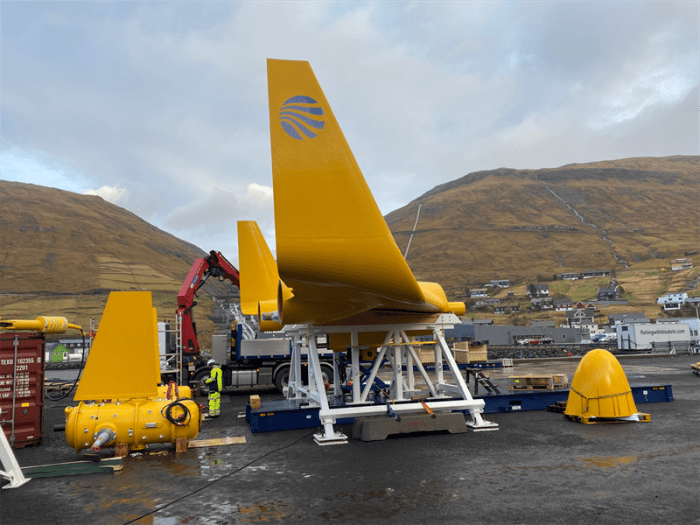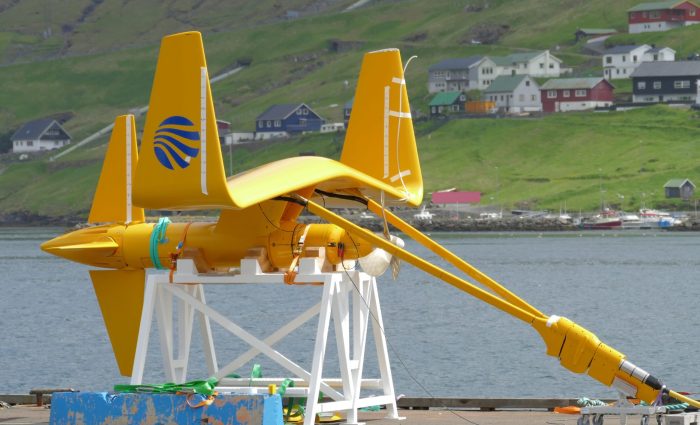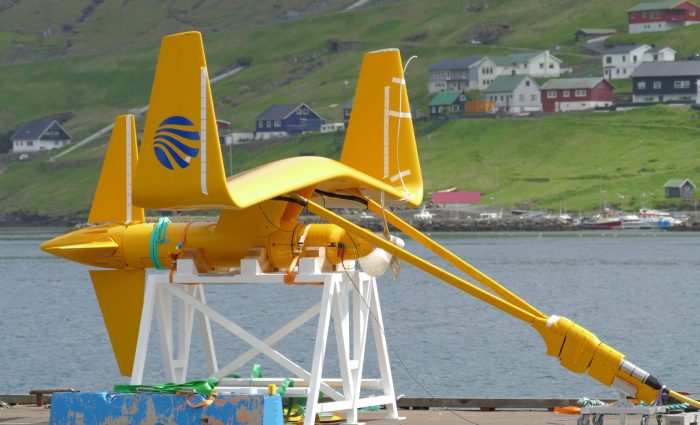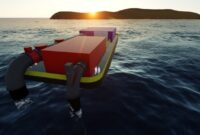Tidal energy kite Minesto is a revolutionary technology that harnesses the power of ocean currents to generate clean, renewable energy. These underwater kites, resembling large underwater drones, are designed to move with the natural flow of tides, generating electricity through a process known as “hydrodynamic lift.” This innovative approach to renewable energy offers a promising solution to the global demand for sustainable energy sources.
The concept of using tidal energy is not new, but Minesto’s approach using kites is unique and holds immense potential. These kites are equipped with advanced sensors and control systems, allowing them to navigate the complex ocean environment efficiently. They are designed to operate in areas with strong tidal currents, ensuring a continuous and reliable energy source.
Tidal Energy Kites

Tidal energy kites, also known as underwater kites or marine kites, are a promising renewable energy technology that harnesses the power of ocean currents. These kites are designed to move through the water in a similar way to traditional kites in the air, generating electricity through a system of tethers and generators.
The Fundamental Principles of Tidal Energy Kite Technology
Tidal energy kites rely on the principle of hydrodynamic lift, similar to how airplanes fly. The kite’s shape and design create a difference in pressure between its upper and lower surfaces when it moves through the water, generating an upward force called lift.
This lift force is counteracted by the weight of the kite and the tension in the tether, resulting in a stable flight path.
Harnessing the Power of Ocean Currents
Tidal energy kites are tethered to a stationary platform on the seabed. As the kite moves through the water, the tension in the tether drives a generator on the platform, producing electricity. The kites are designed to be lightweight and flexible, allowing them to move efficiently through the water and maximize energy generation.
The kites can be deployed in areas with strong tidal currents, such as straits, channels, and estuaries, making them a potentially valuable source of renewable energy.
The History and Evolution of Tidal Energy Kite Technology
The concept of using underwater kites for energy generation has been around for several decades. In the 1980s, researchers at the University of Southampton in the United Kingdom developed a prototype kite system for extracting energy from ocean currents. However, the technology was not commercially viable at the time due to limitations in materials and control systems.In recent years, advancements in materials science, computer modeling, and control systems have led to a resurgence of interest in tidal energy kites.
Several companies and research institutions are now developing and testing prototype kite systems.
- 2008:The company Makani Power, later acquired by Google, began developing airborne wind energy kites. While initially focused on wind energy, the company’s technology paved the way for underwater kite development.
- 2012:The company Minesto, based in Sweden, launched its first commercial-scale tidal energy kite system, called the “Deep Green.” This system was deployed in the Faroe Islands and successfully generated electricity.
- 2018:The company Ocean Power Technologies (OPT) began testing its own tidal energy kite system, called the “PowerBuoy.” This system is designed to be deployed in shallower waters than the Deep Green.
Advantages of Tidal Energy Kites
Tidal energy kites offer several advantages over other renewable energy technologies, such as wind turbines and solar panels.
- High energy density:Tidal currents are generally stronger and more predictable than wind currents, leading to higher energy generation potential.
- Consistent energy production:Tidal currents are driven by the moon’s gravitational pull, resulting in predictable and consistent energy generation throughout the day and night.
- Low environmental impact:Tidal energy kites operate underwater, minimizing visual and noise pollution compared to wind turbines.
- Scalability:Tidal energy kite systems can be scaled up to meet growing energy demands.
Challenges of Tidal Energy Kite Technology
Despite their potential, tidal energy kites face several challenges that need to be addressed before they can become widely adopted.
- High initial costs:Developing and deploying tidal energy kite systems is currently expensive, making them less attractive for investors.
- Technical complexities:Designing and controlling underwater kites is a complex engineering challenge.
- Environmental concerns:The potential impact of tidal energy kites on marine ecosystems needs to be carefully assessed.
Minesso’s Role in Tidal Energy Kite Development
Minesso has emerged as a significant player in the burgeoning field of tidal energy kite technology. The company’s commitment to innovation and its focus on developing practical solutions for harnessing the power of ocean currents have positioned it as a leader in this exciting sector.
Minesso’s Contributions to Tidal Energy Kite Technology
Minesso’s contributions to the tidal energy kite industry are multifaceted. They have played a key role in advancing both the technological and practical aspects of this renewable energy source.
Key Technologies and Innovations
Minesso’s dedication to research and development has led to the creation of several groundbreaking technologies and innovations in the field of tidal energy kites. These advancements have significantly improved the efficiency, reliability, and scalability of this promising renewable energy source.
- Kite Design and Aerodynamics:Minesso has developed innovative kite designs that maximize energy capture while minimizing drag. Their kites are characterized by their lightweight construction, aerodynamic efficiency, and robust design, allowing them to operate effectively in challenging marine environments.
- Control Systems:Minesso has invested heavily in developing sophisticated control systems that enable their kites to navigate ocean currents effectively and maintain optimal flight paths. These systems are designed to be highly responsive, ensuring that the kites can adapt to changing environmental conditions and maximize energy production.
- Tether Management:Minesso has developed innovative tether management systems that ensure the kites’ tethers remain taut and stable, preventing entanglement and maximizing energy transfer. These systems are designed to be robust and reliable, capable of withstanding the harsh conditions of the marine environment.
- Power Generation:Minesso has made significant strides in developing efficient power generation systems that convert the kinetic energy of the kites into usable electricity. These systems are designed to be compact, lightweight, and highly efficient, maximizing energy output while minimizing environmental impact.
The Benefits of Tidal Energy Kites: Tidal Energy Kite Minesto
Tidal energy kites offer a compelling solution to the global energy demand, presenting a unique blend of efficiency, sustainability, and environmental responsibility. This technology leverages the powerful and predictable forces of ocean tides to generate clean energy, making it a valuable asset in the transition to a sustainable energy future.
Advantages over Other Renewable Energy Sources, Tidal energy kite minesto
Tidal energy kites possess several advantages over other renewable energy sources, making them a promising contender in the renewable energy landscape.
- High Energy Density:Tidal currents are characterized by their consistent and predictable nature, offering a reliable source of energy. The high energy density of tidal currents allows for efficient energy extraction, making tidal energy kites a highly productive source of renewable energy.
- Predictability and Reliability:Unlike solar and wind energy, which are subject to fluctuations, tidal currents are highly predictable. This predictability allows for accurate energy generation forecasting, enabling better grid management and integration of tidal energy into existing power systems.
- Low Environmental Impact:Tidal energy kites operate underwater, minimizing visual impact and noise pollution. Unlike wind turbines, they do not interfere with bird migration or bat activity. The submerged nature of tidal energy kites also minimizes the risk of collisions with marine life.
- Scalability:Tidal energy kites can be deployed in various locations, including coastal areas, estuaries, and offshore sites. The technology can be scaled to meet growing energy demands, making it a versatile solution for different energy needs.
Contribution to a Sustainable Energy Future
Tidal energy kites play a crucial role in building a sustainable energy future by:
- Reducing Carbon Emissions:By replacing fossil fuels with clean energy sources, tidal energy kites contribute to mitigating climate change and reducing greenhouse gas emissions.
- Enhancing Energy Security:Tidal energy provides a reliable and domestically sourced energy supply, reducing reliance on imported fossil fuels and enhancing energy security.
- Promoting Economic Growth:The development and deployment of tidal energy kites create new job opportunities in manufacturing, engineering, and research, fostering economic growth and innovation.
Environmental and Economic Impacts of Widespread Adoption
The widespread adoption of tidal energy kites is expected to have positive environmental and economic impacts.
- Reduced Greenhouse Gas Emissions:By replacing fossil fuel power plants with tidal energy, greenhouse gas emissions will be significantly reduced, contributing to a cleaner and healthier environment.
- Increased Biodiversity:The low environmental impact of tidal energy kites allows for the preservation of marine ecosystems and the promotion of biodiversity. The reduced reliance on fossil fuels also minimizes pollution and habitat destruction.
- Economic Growth and Job Creation:The development and deployment of tidal energy kites will create new jobs in manufacturing, engineering, research, and development, fostering economic growth and innovation. The increased energy security will also lead to economic stability and resilience.
Technical Aspects of Tidal Energy Kites
Tidal energy kites are a relatively new technology, but they have the potential to be a significant source of renewable energy. These kites are designed to harness the power of ocean currents, converting the kinetic energy of the water into electricity.
Design and Construction
The design of a tidal energy kite is similar to that of a traditional kite, but with some key differences. Tidal energy kites are typically made of a lightweight, durable material such as carbon fiber or fiberglass. They are also designed to be highly maneuverable, allowing them to move efficiently through the water.The kite consists of two main components: the wing and the tether.
Browse the implementation of hybrid workplace tech companies less inclusive in real-world situations to understand its applications.
The wing is the main component that captures the energy from the ocean currents. It is typically shaped like a traditional kite, but it is often larger and more aerodynamic. The tether is a strong, flexible cable that connects the kite to the generator on the seabed.
Materials Used in Construction
- Carbon Fiber:A lightweight and strong material that is commonly used in the construction of aircraft and other high-performance structures. It is ideal for tidal energy kites due to its high strength-to-weight ratio and resistance to corrosion.
- Fiberglass:Another lightweight and durable material that is often used in the construction of boats and other marine structures. It is a cost-effective alternative to carbon fiber and can be molded into complex shapes.
- Kevlar:A highly durable synthetic fiber that is known for its strength and resistance to abrasion. It is often used in the construction of the tether, as it can withstand the stresses of being submerged in water and being pulled by the kite.
- Polyethylene:A flexible and durable plastic that is often used in the construction of the tether. It is a good insulator and can withstand the harsh conditions of the marine environment.
Mechanics of Power Generation
Tidal energy kites work by harnessing the kinetic energy of ocean currents. The kite is flown through the water, similar to how a traditional kite is flown in the wind. As the kite moves through the water, it generates lift, which pulls on the tether.
The tether is connected to a generator on the seabed, which converts the mechanical energy of the tether’s movement into electricity.The kite’s movement is controlled by a system of control lines, which are attached to the kite and run down to the seabed.
The control lines are used to adjust the kite’s angle of attack, which determines the amount of lift generated. The kite is designed to fly in a figure-eight pattern, which maximizes the amount of energy captured from the ocean currents.
The power output of a tidal energy kite is proportional to the square of the current speed and the area of the kite.
Challenges and Opportunities in Tidal Energy Kite Development

The tidal energy kite industry, though brimming with potential, faces several challenges that need to be addressed for its successful implementation and widespread adoption. However, these challenges also present exciting opportunities for innovation and development, paving the way for a more sustainable future.
Challenges Faced by the Tidal Energy Kite Industry
The development of tidal energy kites is not without its hurdles. Several challenges hinder the widespread adoption of this technology.
- High Initial Investment Costs:The development and deployment of tidal energy kites require significant upfront investments, which can be a barrier for smaller companies and investors. This includes costs for research and development, testing, and manufacturing of the kites, as well as the installation and maintenance of the infrastructure.
- Technical Challenges:The harsh marine environment poses significant challenges for the design and operation of tidal energy kites. These include the need for robust materials and structures to withstand the constant pressure and corrosive salt water, as well as the challenges of maintaining and repairing the kites in the harsh conditions.
- Environmental Concerns:While tidal energy is generally considered a clean and renewable energy source, there are potential environmental impacts associated with the deployment of tidal energy kites. These include the potential for disruption to marine life, noise pollution, and visual impact.
- Limited Scalability:The current technology for tidal energy kites is still in its early stages of development, and there are limitations in terms of scalability. The size and power output of the kites are still relatively small, and the technology needs to be further developed to achieve larger-scale deployment.
- Lack of Public Awareness:The public awareness of tidal energy kites and their potential benefits is still limited. This lack of awareness can hinder the acceptance and support for the development and deployment of this technology.
Opportunities for Further Development and Innovation
Despite the challenges, the potential of tidal energy kites is immense. This technology presents several opportunities for further development and innovation.
- Advancements in Materials and Design:Ongoing research and development in materials science and engineering are leading to the development of stronger, lighter, and more corrosion-resistant materials for tidal energy kites. This will enhance the durability and performance of the kites and reduce maintenance costs.
- Improved Control Systems:Advancements in control systems and automation technology are improving the efficiency and safety of tidal energy kite operations. This includes the development of sophisticated algorithms for navigating and controlling the kites, as well as remote monitoring and control systems.
- Integration with Existing Infrastructure:Tidal energy kites can be integrated with existing offshore wind farms and other marine infrastructure, reducing the costs and complexity of deployment. This can also help to create a more integrated and efficient energy system.
- Increased Public Awareness and Education:Public awareness campaigns and educational programs can help to increase the understanding and acceptance of tidal energy kites. This will foster greater support for the development and deployment of this technology.
- Collaboration and Partnerships:Collaboration between researchers, engineers, policymakers, and industry stakeholders is essential for the successful development and deployment of tidal energy kites. This includes sharing knowledge, resources, and best practices to accelerate progress and overcome challenges.
Advantages and Disadvantages of Tidal Energy Kites
Tidal energy kites offer several advantages over traditional tidal energy technologies, such as tidal turbines. However, they also have some disadvantages.
Advantages
- Higher Energy Efficiency:Tidal energy kites are more efficient than traditional tidal turbines, as they can harness the energy from a larger volume of water. This is because they move through the water column, rather than being fixed in one location.
- Lower Environmental Impact:Tidal energy kites have a lower environmental impact than tidal turbines, as they are less likely to disrupt marine life and cause noise pollution. This is because they are more mobile and can be deployed in areas with less marine activity.
- Scalability and Flexibility:Tidal energy kites can be scaled up or down to meet changing energy demands. They can also be deployed in a variety of locations, including areas where traditional tidal turbines are not suitable.
Disadvantages
- Technical Complexity:Tidal energy kites are more complex than traditional tidal turbines, requiring advanced engineering and control systems. This can make them more expensive to develop and maintain.
- Reliability and Maintenance:The harsh marine environment can pose challenges for the reliability and maintenance of tidal energy kites. They are susceptible to damage from storms, marine growth, and other factors.
- Safety Concerns:The deployment and operation of tidal energy kites can pose safety risks to marine life and human activities. This includes the potential for entanglement, collision, and noise pollution.
The Future of Tidal Energy Kites
The future of tidal energy kites is bright, with the potential to significantly contribute to the global energy mix. As technology advances and costs decrease, tidal energy kites are poised to become a more viable and attractive option for clean energy production.
Potential Role in the Global Energy Mix
Tidal energy kites have the potential to play a significant role in the global energy mix, especially in coastal regions with strong tidal currents. Their ability to generate clean and renewable energy makes them a valuable asset in the fight against climate change.
Here are some potential scenarios for the future of tidal energy kites:
- By 2030, tidal energy kites could contribute a substantial portion of electricity generation in coastal areas with strong tidal currents, such as the UK, France, and the United States.
- By 2040, tidal energy kites could be a major source of renewable energy in many coastal regions, contributing to the global goal of reducing greenhouse gas emissions.
- By 2050, tidal energy kites could be a mainstream source of renewable energy, integrated into smart grids and energy storage systems, providing reliable and sustainable energy to millions of people.
Advancements in Tidal Energy Kite Technology
Significant advancements in tidal energy kite technology are expected in the coming years, further enhancing their efficiency, reliability, and cost-effectiveness.
- Improved Kite Design:Kite designs will be optimized for higher efficiency and power generation, with advancements in materials and aerodynamics.
- Advanced Control Systems:Sophisticated control systems will be developed to ensure optimal kite performance, maximizing energy capture and minimizing operational risks.
- Enhanced Power Transmission:More efficient and reliable power transmission systems will be implemented, enabling the transfer of energy from the kites to the grid with minimal losses.
- Integration with Energy Storage:Tidal energy kites will be integrated with energy storage systems, such as batteries and pumped hydro, to ensure a consistent and reliable energy supply.





